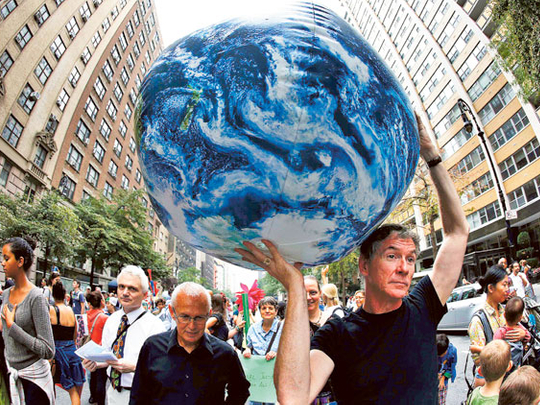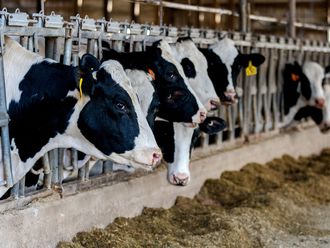
Dubai: More than 300,000 marchers flooded the streets of New York on Sunday in the largest climate change march in history, vaulting the environmental threat to the top of the global agenda. President Barack Obama will also seek to galvanise international support in the fight against climate change today when he addresses the United Nations, with time running out on his hopes of leaving a lasting environmental legacy.
What is climate change?
The planet’s climate has constantly been changing over geological time. The global average temperature today is about 15C, though geological evidence suggests it has been much higher and lower in the past. However, the current period of warming is occurring more rapidly than many past events. Scientists are concerned that the natural fluctuation, or variability, is being overtaken by a rapid human-induced warming that has serious implications for the stability of the planet’s climate.
Who is protesting now?
The New York rally was part of a global protest that included events in 156 countries — Afghanistan, the UK, Italy and Brazil among them. In London, the march attracted an estimated 40,000 people, including actress Emma Thompson who likened the threat from climate change to a Martian invasion. Some 30,000 people marched in Melbourne, Australia. Demonstrators urged Prime Minister Tony Abbott to take action, citing fears that climate change could lead to more bushfires and droughts. Organisers said more than 25,000 marched in Paris. About 15,000 people marched in Berlin. Organisers urged world leaders to recognise climate change as a pressing problem.
Why protest now?
Today, the UN will host a climate summit at its headquarters in New York with 125 heads of state and government — the first such gathering since the unsuccessful climate conference in Copenhagen in 2009. Children born today will see the world committed to dangerous and irreversible levels of climate change by their young adulthood at current rates, as the world poured a record amount of greenhouse gases into the atmosphere this year.
Why the need for action?
Annual carbon dioxide emissions showed a strong rise of 2.5 per cent on 2013 levels, putting the total emitted this year on track for 40 billion tonnes. That means the global ‘carbon budget’, calculated as the total governments can afford to emit without pushing temperatures higher than 2C above pre-industrial levels, is likely to be used up within just one generation, or in thirty years from now.
What do scientists say?
Scientists think climate change is likely to have catastrophic and irreversible effects, including rising sea levels, polar melting, droughts, floods and increasingly extreme weather, if temperatures rise more than 2C. They have calculated that this threshold is likely to be breached if global emissions top 1,200 billion tonnes, giving a “carbon budget” to stick to in order to avoid dangerous warming.
Is time running out?
Dave Reay, professor of carbon management at the University of Edinburgh, said: “If this were a bank statement it would say our credit is running out. We’ve already burned through two-thirds of our global carbon allowance and avoiding dangerous climate change now requires some very difficult choices. Not least of these is how a shrinking global carbon allowance can be shared equitably between more than 7 billion people and where the differences between rich and poor are so immense.”
What’s the worry about China?
The study, by the Global Carbon Project, also found that China’s per capita emissions had surpassed those of Europe for the first time, between 2013 and 2014. The overtaking of Europe by China in terms of emissions per person — about 7.2 tonnes of carbon dioxide per person per year, the study found, compared with Europe’s 6.8 tonnes per person — is politically significant. China has long argued that it should take on far less of the burden of emissions cuts than developed nations, because it bore less responsibility for the stock of carbon poured into the atmosphere since the industrial revolution, and because its emissions per person were lower.
What’s the worry about India?
China and India were the only two nations to hold out almost to the last minute in the talks in 2011 at which governments set the deadline of the Paris talks for the sign-off of a new pact on the climate, to replace current national emissions targets that expire in 2020. India’s per capita emissions are still low, at 1.9 tonnes, but the country’s total emissions are likely to overtake those of the EU by 2019. China’s president, Xi Jinping, has indicated he will not attend Ban Ki-moon’s meeting, as has Narendra Modi, India’s prime minister.
But isn’t this just panic?
Emissions for 2014, according to the research, are set to rise to 40 billion tonnes. That compares with emissions of 32 billion tonnes in 2010, showing how fast the output is rising. The rising trend has continued despite increasingly alarming warnings from scientists over the future of the climate, and commitments by developed countries to cut their carbon and from major developing economies to curb their emissions growth. There was a brief blip in global emissions growth at the time of the banking crisis, but this “breathing space” was quickly overtaken by an expansion in fossil fuel demand.
Isn’t cleaner energy helping?
The growth in emissions also comes despite the much-vaunted contribution of shale gas to the world’s energy mix. Some supporters of the technology claim it will bring down emissions, because gas produces less carbon than coal when burned. But studies have shown that although this may dent the rate at which emissions rise, it is unlikely by itself to produce an absolute fall in carbon output levels. US emissions rose by nearly 3% in 2013, after falling in the previous five years, despite its shale gas boom.
What needs to be done?
As much as half of the world’s proven reserves of all fossil fuels will need to be left in the ground if we are to avoid the worst effects of climate change, research suggests. The study, published as a paper in the peer-review journal Nature Geoscience, called “Persistent growth of CO2 emissions and implications for reaching climate targets”, is a collaboration of research groups around the world.
What will the impacts be?
The scale of potential impacts is uncertain. The changes could drive freshwater shortages, bring sweeping changes in food production conditions, and increase the number of deaths from floods, storms, heatwaves and droughts. Scientists forecast more rainfall overall, but say the risk of drought in inland areas during hot summers will increase. More flooding is expected from storms and rising sea levels. There are, however, likely to be very strong regional variations in these patterns. And the sea levels are rising.
What’s the latest impact?
The president of the Pacific island state of Kiribati favours buying more land abroad after a purchase in Fiji, to secure both food supplies and perhaps a future home if rising sea levels swamp low-lying atolls. Anote Tong, in Norway on a stopover to view melting Arctic ice pushing up sea levels before he attends the summit, said he wanted to lay conditions for “migration with dignity” from the islands.
— Compiled from agencies












